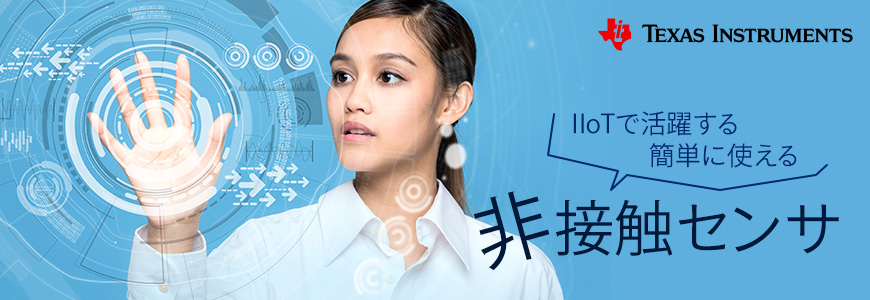If you want to use sensors in the Industrial IoT (hereinafter referred to as IIoT), we recommend non-contact sensors that can detect objects without contact and that do not cause wear or damage to the detection target. However, there are various non-contact sensors such as infrared, magnetic, and optical sensors.
In this article, as a non-contact sensor that can be used easily,
- inductive sensor
- capacitance sensor
- ultrasonic sensor
Focusing on three, we will introduce the detection principle of the sensor and what can be detected by each sensor.
Three representative non-contact sensors and the detection principle of each sensor
First, we briefly explain the detection principles of inductive sensors, capacitive sensors, and ultrasonic sensors. For more details, please refer to the technical articles posted for each item.
inductive sensor
An inductive sensor (inductive proximity sensor) is a proximity sensor that uses the principle of mutual induction.
When a high-frequency signal is supplied to the sensor coil, an electromagnetic field is generated around the coil. When a metal/conductor approaches there, eddy currents flow on the surface of the detection target, and the inductance of the coil changes due to the principle of mutual induction. This change is read by an inductive sensor.
Advantages of inductive sensors
- Only reacts to metals/conductors
- Insensitive to dust and dirt

capacitance sensor
A capacitance sensor measures the change in dielectric constant caused by the approach of another substance (object) to the capacitance formed between a conductive substance (metal, etc.) and the ground as a change in capacitance. A sensor that captures
Capacitance sensors have two types of detection methods: the self-capacitance method and the mutual capacitance method.
For more details, check out this article.
Touch detection is possible even with water droplets! What are the two capacitive methods?
Advantages of capacitive sensors
- Capable of detecting all types of materials, including conductors and insulators
- Not only PCB but also conductor can be used as a sensor depending on the mechanism design method.
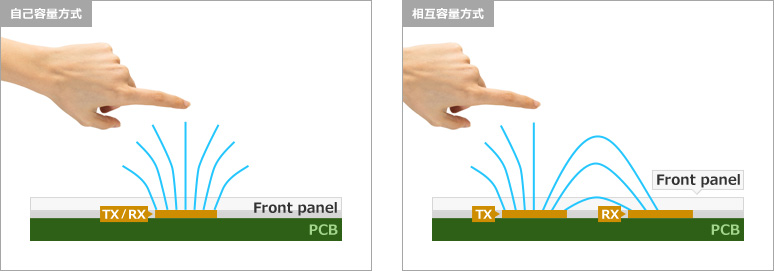
ultrasonic sensor
Ultrasonic sensors measure using a technology called TOF. TOF (Time of Flight) is a method of measuring the time it takes for an emitted object to be reflected by an object and return to the object, and to measure the distance. Light and ultrasonic waves are typical examples of emitted light.
Advantages of Ultrasonic Sensors
- Not affected by color
- Able to detect a wide range of objects
- Insensitive to dust and dirt
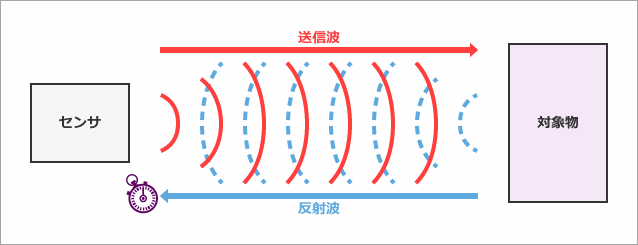
What can be detected by inductive sensors, capacitive sensors, and ultrasonic sensors
The table below shows what can be detected by inductive sensors, capacitive sensors, and ultrasonic sensors.
|
what can be detected |
inductive sensor |
capacitance sensor |
ultrasonic sensor |
|
angle |
○ |
- |
- |
|
Presence or absence of objects (collision avoidance, gesture recognition, position detection, etc.) |
○ |
○ |
○ |
|
Distance |
○ |
○ |
○ |
|
Flow rate |
○ |
- |
○ |
|
Liquid surface |
- |
○ |
○ |
|
touch |
○ |
○ |
- |
Regarding the distance, it is generally said that it is good to select the distance from the target.
Since the distance that can be measured varies for each of the three types of sensors, we recommend that you select one according to the application you are developing.

In addition, it is necessary to select which sensor to use after determining the specifications of the application.
For example, here are just a few of the items:
- Range of detection
- Accuracy of measurement
- size
- How to install the sensor
- Environment where the sensor is installed
From this information, the strengths and weaknesses of each sensor will become clear, so we will narrow it down.
For representative applications of each sensor, please see the sensor demo videos released by Texas Instruments (hereafter TI).
Inductive sensor x touch detection demo video
First, we will introduce the features of the inductive sensor and the device used in this demonstration.
The demo is a demonstration of pressing a metal button using a board with a touch coil. The demo starts at 1:08.
Capacitive sensor x object detection demo video
The first half of this video introduces the advantages of capacitive sensors. In the second half, we will use the evaluation board of the capacitive sensor to demonstrate how to bring your hand closer to the sensor and how to detect people. The demo starts at 2:13.
Click here for a demonstration of liquid level detection with a capacitance sensor
[IoT/M2M Exhibition 2017 Report] IoT PoV Verification Model Exhibit Corner Example of water level measurement
Ultrasonic sensor x liquid level/liquid detection demo video
This video explains how to measure time of flight (TOF) using ultrasound before introducing the demo. The actual demonstration will perform liquid level measurement and liquid identification of water and water with alcohol added.
Evaluation board used in TI's demo video
Inductive sensor: LDC2114EVM
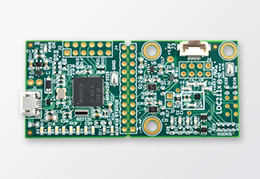
The LDC2114EVM (Evaluation Module) utilizes inductive sensing to detect button presses on solid metal. This EVM can be connected to up to 4 buttons using the LDCTOUCHCOMCOILEVM or customized coils designed with WEBENCH.
- Less than 7uA current consumption at 0.625 samples/s
- Supports up to 4 buttons
- Dedicated button logic output
- Integrated and configurable button press detection algorithm
Inductive Touch Sensor Coil Evaluation Board: LDCTOUCHCOMCOILEVM
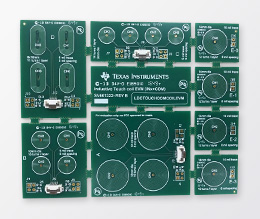
The LDCTOUCHCOMCOILEVM is designed to provide maximum flexibility for system prototyping for inductive touch applications, allowing evaluation with different coil sizes. It incorporates 4 each of 5 different size PCB coils with integrated spacers and perforations so that the coils can be separated and glued to any surface to measure metal deflection. increase.
- Equipped with 4 each of 5 types of coils with different sizes for prototyping
- Integral spacer for easy attachment to the button surface
- Easy-to-use connectors from sensor coil boards to device boards
Capacitive sensor: FDC2214EVM
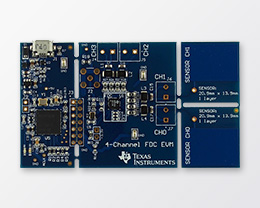
The FDC2214EVM (Evaluation Module) uses capacitive technology to enable presence detection of any target object, which can be either inductive or non-inductive. The module comes with two PCB capacitive sensor examples that connect to two of the four channels of the FDC2214. An MSP430 MCU is used as the interface between the FDC and the host computer.
- Multiple Holes on Board: Maximize Evaluation and System Design Flexibility
- PCB capacitive sensor example for 2 different channels
- Operated from PC via USB interface
- Included GUI enables rapid concept implementation and data capture
Ultrasonic sensor: TDC1000-C2000EVM
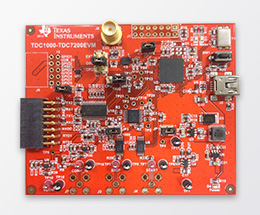
*Since the production of the "TDC1000-TDC7200EVM" introduced in the video has been discontinued, we will introduce a replacement product.
The TDC1000-C2000EVM is an evaluation module for the ultrasonic AFE TDC1000. It also has a real-time control microcomputer C2000 and can evaluate the operation and performance of the TDC1000.
This module can be used for many ultrasonic sensing applications such as automotive liquid level detection, concentration and liquid identification, proximity or distance measurement.
- User friendly GUI interface
- Process data using onboard C2000-TMS320F28035PAG
- 2 ultrasonic transducer connectors and 2 RTD sensor connectors
- Powered from USB
Contact Us
If you would like more information about TI's development kits and sensor products introduced in this article, please contact us here.
*This article was written based on the product status at the time. When considering a product, please confirm the latest information with the manufacturer or distributor before proceeding.
Related information
Click here for recommended articles/materials
Capacitive touch sensing can be realized only with a microcomputer! What is CapTIvate Technology?
Principles and Features of Ultrasonic Sensors
What is a millimeter wave sensor? -Overview in 5 minutes-
Gesture Recognition with Millimeter-Wave Sensors -Utilization in Medical Fields/Factory-
Let's make a capacitive water level sensor Episode 1 Prototype of a water level sensor
What is a sensor? Basic knowledge for digitization and IoT

